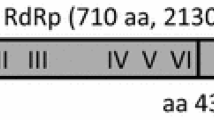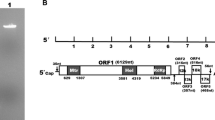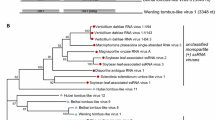Abstract
The European race of Gremmeniella abietina (Lagerberg) Morelet is the causal agent of stem canker and shoot blight on numerous conifers in Europe and North America. It comprises different species and biotypes in which the presence of mycoviruses has been determined. In this report, we describe the full-length sequence of the RNA-dependent RNA polymerase (RdRp) of a putative novel virus, Gremmeniella abietina RNA virus 6 (GaRV6), with 2165 nt and a GC content of 54.7 %. A BLASTp search using the deduced RdRp amino acid sequence confirmed GaRV6 to be related to members of a still unassigned virus taxon, which includes, e.g., Fusarium graminearum dsRNA mycovirus 4 (FgV-4) and the mutualistic Curvularia thermal tolerance virus (CThTV). The prevalence and genetic diversity of GaRV6 was also studied within the European race of G. abietina. We examined 162 isolates originating from Canada, the Czech Republic, Finland, Italy, Montenegro, Serbia, Spain, Switzerland, Turkey and the United States. According to direct specific reverse transcription (RT) PCR screening based on the RdRp sequence, the virus appears to be present only in Spain, where it is relatively abundant but genetically highly uniform.



Similar content being viewed by others
References
Anaya N, Roncero MIG (1995) Skippy, a retrotransposon from the fungal plant pathogen Fusarium oxysporum. Mol Gen Genet 249:637–647
Botella L, Diez JJ (2010) Phylogenic diversity of fungal endophytes in Spanish stands of Pinus halepensis. Fungal Divers 47:9–18
Botella L, Santamaría O, Diez JJ (2010) Fungi associated with the decline of Pinus halepensis in Spain. Fungal Divers 40:1–11
Botella L, Tuomivirta TT, Kaitera J, Carrasco-Navarro V, Diez JJ, Hantula J (2010) Spanish population of Gremmeniella abietina is genetically unique but related to type A in Europe. Fungal Biol 114:778–789
Botella L, Tuomivirta TT, Hantula J, Diez JJ (2012) Presence of Viral dsRNA molecules in the Spanish population of Gremmeniella abietina. J Agric Ext Rural Dev 4:211–213
Botella L, Tuomivirta TT, Vervuurt S, Diez JJ, Hantula J (2012) Occurrence of two different species of mitoviruses in the European race of Gremmeniella abietina var. abietina, both hosted by the genetically unique Spanish population. Fungal Biol 116:872–882
Botella L, Tuomivirta TT, Hantula J, Diez JJ, Jankovsky L (2015) The European race of Gremmeniella abietina host a single species of Gammapartitivirus with global distribution and possible recombinant events in its history. Fungal Biol 119:125–135
Bruenn JA (1993) A closely related group of RNA-dependent RNA polymerases from double-stranded RNA viruses. Nucleic Acids Res 21:5667–5669
Chu Y, Jeon J, Yea S, Kim Y, Yun S, Lee Y, Kim K (2002) Double-Stranded RNA Mycovirus from Fusarium graminearum. Appl Environ Microbiol 68:2529–2534
Chu Y, Lim W, Yea S, Cho J, Lee Y, Kim K (2004) Complexity of dsRNA mycovirus isolated from Fusarium graminearum. Virus Genes 28:135–143
Dogmus-Lehtijarvi HT, Oskay F, Lehtijarvi A (2012) Susceptibility of Pinus nigra and Cedrus libani to Turkish Gremmeniella abietina isolates. For Syst 21:306–312
Donaubauer E (1972) Distribution and hosts of Scleroderris lagerbergii in Europe and North America. Eur J For Pathol 9:316–322
Ghabrial SA, Suzuki N (2009) Viruses of plant pathogenic fungi. Annu Rev Phytopathol 47:353–384
Gruber AR, Lorenz R, Bernhart SH, Neubock R, Hofacker IL (2008) The Vienna RNA website nucleic acids research 36: web server issue
Hamelin RC, Lecours N, Hansson P, Hellgren M, Laflamme G (1996) Genetic differentiation within the European race of Gremmeniella abietina. Mycol Res 100:49–56
Hausner G, Belkhiri A, Klassen GR (2000) Phylogenetic analysis of the small subunit ribosomal RNA gene of the hyphochytrid Rhizidiomyces apophysatus. Can J Bot 78:124–128
Hellgren M, Högberg N (1995) Ecotypic variation of Gremmeniella abietina in northern Europe: disease patterns reflected by DNA variation. Can J Bot 73:1531–1539
Hillman BI, Shapira R, Nuss DL (1990) Hypovirulence- associated suppression of host functions in Cryphonectria parasitica can be partially relieved by high light intensity. Phytopathol 80:950–956
Hyder R, Pennanen T, Hamberg L, Vainio EJ, Piri T, Hantula J (2013) Two viruses of Heterobasidion confer beneficial, cryptic or detrimental effects to their hosts in different situations. Fungal Ecol 6:387–396
Jiang Y, Zhang T, Luo C, Jiang D, Li G, Li Q, Huang J (2015) Prevalence and diversity of mycoviruses infecting the plant pathogen Ustilaginoidea virens. Virus Res 195:47–56
Jukes TH, Cantor CR (1969) Evolution of protein molecules. In: Munro HN (ed) Mammalian protein metabolism. Academic Press, New York, pp 21–132
Kaitera J, Jalkanen R (1996) In vitro growth of Gremmeniella abietina isolates (European race) at different temperatures. Scan J For Res 11:159–163
Laflamme G, Lachance D (1987) Large infection center of scleroderris canker (European race) in Quebec province. Plant Dis 71:1041–1043
Librado P, Rozas J (2009) DnaSP v5: a software for comprehensive analysis of DNA polymorphism data. Bioinformatics 25:1451–1452
Marquez LM, Redman RS, Rodriguez RJ, Roossinck MJ (2007) A virus in a fungus in a plant: three-way symbiosis required for thermal tolerance. Science 315:513–515
Morris TJ, Dodds JA (1979) Isolation and analysis of double- stranded-RNA from virus infected plant and fungal tissue. Phytopathol 69:854–858
Nei M, Gojobori T (1986) Simple methods for estimating the numbers of synonymous and nonsynonymous nucleotide substitutions. Mol Bio Evol 3:418–426
Nibert ML, Ghabrial SA, Maiss E, Lesker T, Vainio EJ, Jiang D, Suzuki N (2014) Taxonomic reorganization of family Partitiviridae and other recent progress in partitivirus research. Virus Res 188:128–141
Peterson-Burch BD, Voytas DF (2002) Genes of the Pseudoviridae (Ty1/copia retrotransposons). Mol Biol Evol 19:1832–1845
Romeralo C, Botella L, Santamaria O, Diez J (2012) Effect of putative mitoviruses on in vitro growth of Gremmeniella abietina isolates under different laboratory conditions. For Syst 21:515–525
Santamaria O, Alves-Santos FM, Diez JJ (2005) Genetic characterization of Gremmeniella abietina var. abietina isolates from Spain. Plant Pathol 54:331–338
Skilling DD (1977) Development of a more virulent strain of Scleroderris lagerbergii in New York State. Eur J For Pathol 7:297–302
Tamura K, Stecher G, Peterson D, Filipski A, Kumar S (2013) MEGA6: molecular evolutionary genetics analysis version 60. Mol Biol Evol 30:2725–2729
Tuomivirta TT, Uotila A, Hantula J (2002) Two independent doubled- stranded RNA patterns occur in the Finnish Gremmeniella abietina var. abietina type A. For Pathol 32:197–205
Tuomivirta TT, Hantula J (2003) Two unrelated double-stranded RNA molecule patterns in Gremmeniella abietina type A code for putative viruses of the families Totiviridae and Partitiviridae. Arch Virol 148:2293–2305
Tuomivirta TT, Hantula J (2003) Gremmeniella abietina mitochondrial RNA virus S1 is phylogenetically related to the members of the genus Mitovirus. Arch Virol 148:2429–2436
Tuomivirta TT, Hantula J (2005) Three unrelated viruses occur in a single isolate of Gremmeniella abietina var. abietina type A. Virus Res 110:31–39
Tuomivirta TT, Kaitera J, Hantula J (2010) A novel putative virus of Gremmeniella abietina type B, Ascomycota: Helotiaceae has a composite genome with endornavirus affinities. J Gen Virol 90:2299–2305
Uotila A (1983) Physiological and morphological variation among Finnish Gremmeniella abietina isolates. In: Communications Instituti Forestalis Fenniae Report, Helsinki
Uotila A (1988) The effect of climatic factors on the occurrence of Scleroderris canker. Folia For 721:1–23
Uotila A (1992) Mating system and apothecia production in Gremmeniella abietina. Eur J For Pathol 22:410–417
Uotila A, Hantula J, Vaatanen AK, Hamelin R (2000) Hybridization between two biotypes of Gremmeniella abietina var. abietina in artificial pairings. For Pathol 30:211–219
Uotila A, Hantula J (2012) The Gremmeniella spp. taxonomy- types, races or species? In: Proceeding of IUFRO 2013 WP 7.02.02 Foliage, shoot and stems diseases Brno and Cerna Hora, Czech Republic, p 53
Vainio EJ, Hyder R, Aday G, Hansen E, Piri T, Dogmus-Lehtijarvi T, Lehtijarvi A, Korhonen K, Hantula J (2012) Population structure of a novel putative mycovirus infecting the conifer root-rot fungus Heterobasidion annosum sensu lato. Virology 422:366–376
Vainio EJ, Jurvansuu J, Streng J, Rajamäki M, Jarkko Hantula J, Valkonen JPT (2015) Diagnosis and discovery of fungal viruses by deep sequencing of small RNAs. J Gen Virol 96:714–725
Vainio EJ, Müller MM, Korhonen K, Piri T, Hantula J (2015) Viruses accumulate in aging infection centers of a fungal forest pathogen. ISME J 9:497–507
Yu X, Li B, Fu Y, Jiang D, Ghabrial S et al (2010) A geminivirus-related DNA mycovirus that confers hypovirulence to a plant pathogenic fungus. PNAS 107:8387–8392
Lin Y, Zhang H, Zhao C, Liu S, Guo L (2014) The complete genome sequence of a novel mycovirus from Alternaria longipes strain HN28. Arch Virol 160:577–580
Yu J, Kwon SJ, Lee KM, Son M, Kim KH (2009) Complete nucleotide sequence of double-stranded RNA viruses from Fusarium graminearum strain DK3. Arch Virol 154:1855–1858
Zheng L, Liu H, Zhang M, Cao X, Zhou E (2013) The complete genomic sequence of a novel mycovirus from Rhizoctonia solani AG-1 IA strain B275. Arch Virol 158:1609–1612
Acknowledgments
This research was developed in the Czech Republic thanks to the projects OPVK “PhD researchers in the field of technical and economic sciences at MENDELU” (CZ.1.07/2.3.00/30.0017) and “Indicators of tree vitality” (CZ.1.07/2.3.00/20.0265), both supported by the OP Education for Competitiveness, the European Social Fund and the Czech Ministry of Education, Youth and Sport. However, it was started in Finland, thanks to a Ph.D. Grant from the University of Valladolid, and the project AGL2008-03622 of the Ministry of Culture and Science (Spain). EJV and JH received financial support from the Academy of Finland (Decision Numbers 251193 and 258520).
Author information
Authors and Affiliations
Corresponding author
Electronic supplementary material
Below is the link to the electronic supplementary material.
Rights and permissions
About this article
Cite this article
Botella, L., Vainio, E.J., Hantula, J. et al. Description and prevalence of a putative novel mycovirus within the conifer pathogen Gremmeniella abietina . Arch Virol 160, 1967–1975 (2015). https://doi.org/10.1007/s00705-015-2456-5
Received:
Accepted:
Published:
Issue Date:
DOI: https://doi.org/10.1007/s00705-015-2456-5




